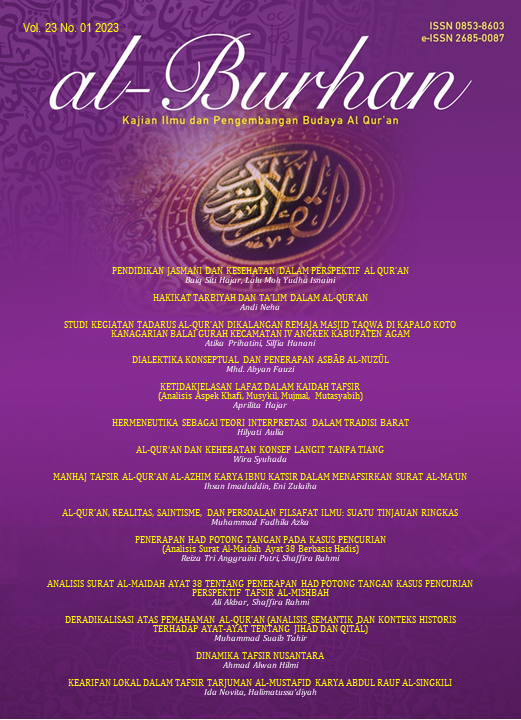AL-QUR'AN DAN KEHEBATAN KONSEP LANGIT TANPA TIANG
Keywords:
the concept of heaven; the Quran; symbolismAbstract
The article also explores the concept of pillars in the Quran and their differences from the Western view. In the Quran, pillars are often used as a symbol of stability and strength, representing the steadfastness of believers in their faith. This concept is different from the Western view, where pillars are often seen as mere structural elements that provide support. The philosophical implications of a pillar-less sky in the Quran are also discussed in the article. The symbolism of a pillar-less sky represents the idea of unity and impartiality in Islam, which emphasizes the importance of a unified and impartial approach to life. This concept has practical implications in everyday life, as it encourages individuals to adopt an open-minded and inclusive attitude towards others. Overall, this article aims to provide a deeper understanding of the Quranic concept of a pillar-less sky and its philosophical implications in everyday life. By exploring the symbolism and significance of this concept, readers can gain a greater appreciation of the wisdom and guidance offered by the Quran in understanding the universe and living a fulfilling life
References
Adil Abdul Haq dan Abdul Majid Awan. Qur'an and Science: In-Depth Analysis. Pakistan: International Islamic University Islamabad, 2009.
Ahmad bin Hanbal. Musnad Ahmad bin Hanbal, Beirut, Lebanon: Dar al-Kutub al-Ilmiyah.
Al-Bukhari, Muhammad bin Ismail. Adab al-Mufrad. Bab: Ketakwaan kepada Allah dan Merendahkan Diri. Beirut Lebanon : Dar al-Ma'rifa, 1986.
Al-Ghazali, Abu Hamid Muhammad. Ihya Ulumuddin. Jakarta: Penerbit Zaman, 2017.
Ali, Abdullah Yusuf. The Holy Qur'an: Text, Translation and Commentary. Tahrike Tarsile Qur'an, 2010.
Ali-Fauzi, Ihsan. Kosmos dan Kedalaman: Refleksi Epistemologi dan Spiritual atas Langit dan Bintang dalam Tradisi Islam. Mizan, 2018.
Ar-Raniry, Nuruddin. Tafsir al-Qur'an al-Karim. Jakarta: Pustaka Imam Syafi'I, 2015.
Baker, David. The History of Manned Spaceflight. London: Amber Books Ltd, 2014.
Berman, M. The reenchantment of the world. Cornell University Press, 1981.
Bukhari, Muhammad ibn Isma'il. Sahih al-Bukhari. Terjemahan oleh Muhammad Muhsin Khan. Darussalam Publishers, 1997.
Capra, F. The Tao of Physics: An Exploration of the Parallels between Modern Physics and Eastern Mysticism. Shambhala Publications, 1991.
Djamarah, Syaiful Bahri & Zain, Aswan. Strategi Belajar Mengajar. Jakarta: Rineka Cipta, 2018.
Effendi, Rusli. Ilmu Alamiah Dasar. Jakarta: PT Gramedia Pustaka Utama, 2016.
Esposito, John L. The Oxford Dictionary of Islam. Oxford University Press, 2003.
Fakhruddin, Ahmad. "Konsep Langit Tanpa Tiang dalam Al-Qur'an". Jurnal Ilmiah Pendidikan Islam 3 (2), 2015.
Fazlur Rahman. Major Themes of the Qur'an. University of Chicago Press, 2009.
Hasan, Noorhaidi. "Menafsirkan Al-Qur'an: Kajian atas Metodologi Tafsir Kontekstual". Jurnal Studia Islamika, 24 (2), 2017.
Hawking, S. A Brief History of Time. Bantam Books, 1988.
Ibnu Katsir, Abi al-Fadai al-Hafidz. Tafsir Al-Qur'an Al-'Azim. Beirut Lebanon: Dar al-Fikr, 1999.
Ibn Manzur, Muhammad b. Mukarram. Lisan al-'Arab. Beirut: Dar Sader, 1993, jilid 10.
Sulaiman, Abu Dawud ibn al-Ash'ath. Sunan Abu Dawud. Terjemahan oleh Yaser Qadhi. Al-Madina Publications, 2008.
Soemardi, Ahmad & Wibowo, Wuri. Kajian Tafsir Kontemporer. Jakarta: Kencana Prenada Media Group, 2017.
Thabari, Abu Ja'far Muhammad Bin Jarir Ath-. Tafsir Al-Tabari. Dar al-Fikr, 1997, Jilid 1.

1_(1).jpg)
